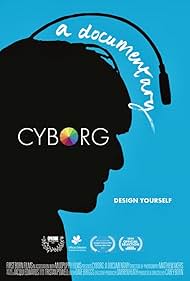Eye For Film >> Movies >> Cyborg: A Documentary (2023) Film Review
Cyborg: A Documentary
Reviewed by: Jennie Kermode

When people see Neil Harbisson in the street, they often laugh at his antenna. When they learn what it does, they gaze at him in awe. He may be an odd-looking man, but it’s not the way he looks that really commands attention. It’s the way he sees.
Harbisson was born with achromatism, a genetic variation which means that he can only see in black and white. In the early scenes of Carey Born’s documentary, he explains how, as a young child, he gradually figured out that his normal was different from most other people’s. He became interested in the theory of colour, read all the books, familiarised himself with it at a level that most people never do, but the experience of it remained a mystery. Eventually he found a doctor who was willing to implant the antenna, a direct interface between a tiny sensor and his brain. Through it, he hears tones corresponding to colour, which his unconscious has gradually learned to process separately from sound or vision.

“Designing myself set me free from the limits of my body and mind,” he says.
Though there have been rumours of experiments like this going back a long way, Harbisson is the world’s first recognised cyborg. As such, he has had to forge a difficult path, both technologically and socially. He has face objections from medical ethicists who are fine with the idea of compensating for disability but don’t like the idea of giving humans new or unusual powers (his favourite colour is infrared and he speculates that if people could see all the screeching ultraviolet down at the beach then they wouldn’t be so quick to expose themselves, and cancer rates would fall). He has received death threats, including one, from a man who said he wanted to be the first person to kill a cyborg, that scared him so much that he moved countries. But he has also connected with a growing community of people who likewise want to expand their sensory potential, and to connect with the world and one another in new ways.
Though the subject may seem exotic, the film hinges on a very familiar struggle: those who prefer to define the world by way of fixed static categories, and instinctively fear change; and those who see natural boundaries as innately fuzzy, with change and exploration themselves part of the natural order. Harbisson is an artist, and uses his sensory difference to create works that prompt other people to think differently. He creates sound portraits of public figures: Prince Charles, Nicole Kidman, Tracy Emin, Al Gore. He transposes pieces of music and famous speeches into colour. We also see him reacting to other people’s art and, in one scene, to an optical illusion. He talks about the discoveries that he made in the process of familiarising himself with colour, such as the discovery that people were not black or white but, rather, different shades of orange.
The film is just 77 minutes long, but packs a lot in, and you will be left full of questions, with prompts to explore further should you wish to. Harbisson is very personable and makes a great storyteller, for all that he says that his implant failed to bring him closer to other humans as he had thought it might – instead he feels closer to insects and dolphins. His account is supported by material from his soulmate, fellow artist Moon Ribas. Clips from assorted science fiction films help to set the mood. At a pivotal moment, we watch the creation of Hel in Fritz Lang’s Metropolis (interestingly, not the colourised version).
Some important questions are left until late, perhaps for impact. At a talk that Harbisson is giving, an audience member expresses concern that cybernetics could further empower the wealthy and create an insurmountable social division. Harbisson counters that he doesn’t see that as a risk in practice because these technologies are, in fact, really cheap. Enthusiasts are designing them on an open source basis. They can be 3D printed at home. The next generation of modifications is likely to be genetic, which would give prospective adopters a whole lot of other things to think about, but that wouldn’t stop them from being available to everyone.
Ironically, this film may itself prove less accessible. We hear some of those colour tones, and they’re likely to play havoc with induction loops for D/deaf viewers, as well as causing difficulties for some neurodivergent audience members. They are used only briefly, however, so go prepared and you can probably work around the problem. It’s worth making an effort for this fascinating piece of work.
Reviewed on: 19 Sep 2024















